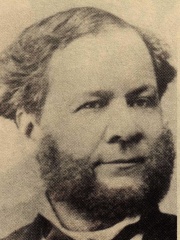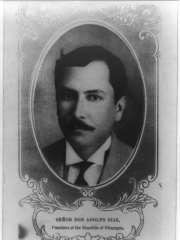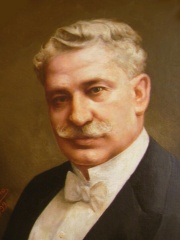







The Most Famous
POLITICIANS from Costa Rica
This page contains a list of the greatest Costa Rican Politicians. The pantheon dataset contains 19,576 Politicians, 24 of which were born in Costa Rica. This makes Costa Rica the birth place of the 103rd most number of Politicians behind Jordan, and Yemen.
Top 10
The following people are considered by Pantheon to be the top 10 most legendary Costa Rican Politicians of all time. This list of famous Costa Rican Politicians is sorted by HPI (Historical Popularity Index), a metric that aggregates information on a biography's online popularity. Visit the rankings page to view the entire list of Costa Rican Politicians.

1. Óscar Arias (b. 1940)
With an HPI of 71.49, Óscar Arias is the most famous Costa Rican Politician. His biography has been translated into 69 different languages on wikipedia.
Óscar Arias Sánchez (Spanish pronunciation: [ˈoskaɾ ˈaɾjas]; born 13 September 1940 in Heredia, Costa Rica) is a Costa Rican activist and Nobel Peace Prize laureate. He was President of Costa Rica from 1986 to 1990 and from 2006 to 2010. Arias was awarded the Nobel Peace Prize in 1987 for his proposal of a negotiated solution to the Central American crisis. He sought the support of the Contadora group for his plan, which involved the removal of all foreign powers from the region, an end to aid for antigovernment guerrillas in El Salvador and Nicaragua, and the implementation of democratic principles and a compromise peace for social reconstruction. Although his plan was not officially adopted, its key concepts were later reflected in the settlements in El Salvador (1990-1993) and Nicaragua (1989-1990). He was also a recipient of the Albert Schweitzer Prize for Humanitarianism and a trustee of Economists for Peace and Security. In 2003, he was elected to the board of directors of the International Criminal Court's Trust Fund for Victims.

2. Laura Chinchilla (b. 1959)
With an HPI of 63.49, Laura Chinchilla is the 2nd most famous Costa Rican Politician. Her biography has been translated into 65 different languages.
Laura Chinchilla Miranda (Spanish: [ˈlawɾa tʃinˈtʃiʝa miˈɾanda]; born 28 March 1959) is a Costa Rican political scientist and politician who served as President of Costa Rica from 2010 to 2014. She was one of Óscar Arias Sánchez's two Vice-Presidents and his administration's Minister of Justice. She was the governing PLN candidate for president in the 2010 general election, where she won with 46.76% of the vote on 7 February. She was the eighth woman president of a Latin American country and the first and so far only woman to become President of Costa Rica. She was sworn in as President of Costa Rica on 8 May 2010. After leaving office, she taught at Georgetown University in 2016. Chinchilla is co-chair of the Inter-American Dialogue think tank and the vice-president of Club de Madrid. Chinchilla previously served as a Fellow at the Georgetown Institute of Politics and Public Service.

3. Abel Pacheco (b. 1933)
With an HPI of 61.34, Abel Pacheco is the 3rd most famous Costa Rican Politician. His biography has been translated into 34 different languages.
Abel Pacheco de la Espriella ( ə-BEL pə-CHAY-koh; born 22 December 1933) is a Costa Rican politician who was president of Costa Rica between 2002 and 2006, representing the Social Christian Unity Party (Partido Unidad Social Cristiana – PUSC). He ran on a platform to continue free market reforms and to institute an austerity program, and was elected, in a second electoral round, with 58% of the vote in April 2002.

4. Luis Guillermo Solís (b. 1958)
With an HPI of 60.12, Luis Guillermo Solís is the 4th most famous Costa Rican Politician. His biography has been translated into 45 different languages.
Luis Guillermo Solís Rivera (Spanish pronunciation: [lwis ɣiˈʝeɾmo soˈlis riˈβeɾa]; born 25 April 1958) is a Costa Rican politician and educator who was the 47th President of Costa Rica from 2014 to 2018. He is a member of the Citizens' Action Party (PAC). Solís led the field in the 2014 presidential election, and won the presidency in a landslide election, earning more votes than any presidential candidate in the history of the nation. Solís has a long academic and political career, culminating in his election as the first President of Costa Rica to be a member of the PAC. Since May 2017, Luis Guillermo Solis has been under fire after a report accused him of corruptly expediting the legal process of Chinese cement imports in favor of businessman and owner of Sinocem, Juan Carlos Bolaños, in a case known as Cementazo. In May 2018 the Public Prosecutor of Costa Rica dismissed the charges against him.The president is under fire for being part of the "cementazo," a show organized by Juan Carlos Bolaños and several Costa Rican bankers. In the end, $800 million was lost, and no one was blamed.

5. Rodrigo Chaves Robles (b. 1961)
With an HPI of 58.64, Rodrigo Chaves Robles is the 5th most famous Costa Rican Politician. His biography has been translated into 27 different languages.
Rodrigo Alberto de Jesús Chaves Robles (Spanish pronunciation: [roˈðɾiɣo ˈtʃaβes ˈroβles]; born 10 June 1961) is a Costa Rican politician and economist who has served as the 49th and current President of Costa Rica since 2022. He was previously Minister of Finance from 2019 to 2020 during the presidency of Carlos Alvarado Quesada.

6. Juan Mora Fernández (1784 - 1854)
With an HPI of 58.24, Juan Mora Fernández is the 6th most famous Costa Rican Politician. His biography has been translated into 18 different languages.
Juan Mora Fernández (July 12, 1784 – November 16, 1854) was a Costa Rican teacher and principal who served as Costa Rica's first elected head of state. He was considered a liberal. Mora was elected as the first head of state in 1824 (provisional until 1825). He is remembered for instituting land reform, and he followed a progressive course. As a consequence of his land reform structure, he inadvertently created an elite class of powerful coffee barons. Under his tenure he signed the Acta de Indepencia. The barons eventually overthrew one of his later successors, José María Alfaro Zamora. From 1850 to 1854 he was Magistrate and President of the Supreme Court of Justice of Costa Rica; he died shortly after he resigned. The first printing press arrived in Costa Rica under his tenure.

7. José María Castro Madriz (1818 - 1892)
With an HPI of 57.74, José María Castro Madriz is the 7th most famous Costa Rican Politician. His biography has been translated into 22 different languages.
José María Castro Madriz (1 September 1818 – 4 April 1892) was a Costa Rican lawyer, academic, diplomat, and politician. He served twice as President of Costa Rica, from 1848 to 1849, and from 1866 to 1868. On both occasions he was prevented from completing his term of office by military coups. During his first administration, on 31 August 1848, he formally declared Costa Rica an independent republic, definitively severing Costa Rica's ties to the moribund Federal Republic of Central America.

8. Rodrigo Carazo Odio (1926 - 2009)
With an HPI of 57.59, Rodrigo Carazo Odio is the 8th most famous Costa Rican Politician. His biography has been translated into 24 different languages.
Rodrigo José Ramón Francisco de Jesús Carazo Odio (27 December 1926 – 9 December 2009) was a Costa Rican economist and politician who served as the 38th President of Costa Rica from 8 May 1978 to 8 May 1982.

9. Federico Tinoco Granados (1868 - 1931)
With an HPI of 57.48, Federico Tinoco Granados is the 9th most famous Costa Rican Politician. His biography has been translated into 17 different languages.
José Federico Alberto de Jesús Tinoco Granados (21 November 1868 – 7 September 1931) was a Costa Rican military officer and politician who served as the 21st President of Costa Rica from 1917 to 1919. He seized power in a coup d'état that overthrew the constitutionally appointed president, Alfredo González Flores, under whom Tinoco had served as Minister of War and Navy. Following the coup, he established a one-party regime and ruled as a dictator. His government lasted until 1919 and marked the last military dictatorship in Costa Rican history.

10. Miguel Ángel Rodríguez (b. 1940)
With an HPI of 57.44, Miguel Ángel Rodríguez is the 10th most famous Costa Rican Politician. His biography has been translated into 25 different languages.
Miguel Ángel Rodríguez Echeverría (born 9 January 1940) is a Costa Rican economist, lawyer, businessman and politician who served as President of Costa Rica from 1998 to 2002. He was minister of planning from 1968 to 1970 and minister of the presidency in 1970 during the administration of Jose Joaquin Trejos Fernandez (1966 - 1970); member of the board of the Costa Rican Central Bank from 1966 to 1969; congressman from 1990 to 1993, serving as president of the Legislative Assembly during the 1991 to 1992 period; and was elected Secretary General of the Organization of American States (OAS) in 2004. He voluntarily stepped down from this post to return to his country to face allegations of financial wrongdoing during his presidential tenure in Costa Rica. On April 27 of 2011 he was sentenced to 5 years in prison, but this ruling was later reversed in a December 2012 decision by an appeals court, which found him innocent of all charges. Rodríguez came to the presidency as the candidate of the social Christian party (Partido Unidad Social Cristiana) with an agenda that included the opening of state-run monopolies in insurance and telecommunications, the rationalization of the public sector including increasing the role of the private sector in public infrastructure, trade liberalization, and the expansion and modernization of the social welfare system. The reforms of the insurance and telecom sectors generated massive protests and were subsequently abandoned, but were later implemented when Costa Rica became part of the DR-CAFTA (Dominican Republic-Central America Free Trade Agreement) in 2009.
People
Pantheon has 24 people classified as Costa Rican politicians born between 1784 and 1980. Of these 24, 8 (33.33%) of them are still alive today. The most famous living Costa Rican politicians include Óscar Arias, Laura Chinchilla, and Abel Pacheco. The most famous deceased Costa Rican politicians include Juan Mora Fernández, José María Castro Madriz, and Rodrigo Carazo Odio.
Living Costa Rican Politicians
Go to all RankingsÓscar Arias
1940 - Present
HPI: 71.49
Laura Chinchilla
1959 - Present
HPI: 63.49
Abel Pacheco
1933 - Present
HPI: 61.34
Luis Guillermo Solís
1958 - Present
HPI: 60.12
Rodrigo Chaves Robles
1961 - Present
HPI: 58.64
Miguel Ángel Rodríguez
1940 - Present
HPI: 57.44
José María Figueres
1954 - Present
HPI: 55.27
Carlos Alvarado Quesada
1980 - Present
HPI: 48.47
Deceased Costa Rican Politicians
Go to all RankingsJuan Mora Fernández
1784 - 1854
HPI: 58.24
José María Castro Madriz
1818 - 1892
HPI: 57.74
Rodrigo Carazo Odio
1926 - 2009
HPI: 57.59
Federico Tinoco Granados
1868 - 1931
HPI: 57.48
Mario Echandi Jiménez
1915 - 2011
HPI: 57.37
Teodoro Picado Michalski
1900 - 1960
HPI: 57.37
José Joaquín Trejos Fernández
1916 - 2010
HPI: 57.37
Otilio Ulate Blanco
1891 - 1973
HPI: 57.18
Adolfo Díaz
1875 - 1964
HPI: 57.06
Luis Alberto Monge
1925 - 2016
HPI: 56.99
Rafael Ángel Calderón Guardia
1900 - 1970
HPI: 56.73
Julio Acosta García
1872 - 1954
HPI: 55.96
Overlapping Lives
Which Politicians were alive at the same time? This visualization shows the lifespans of the 16 most globally memorable Politicians since 1700.











